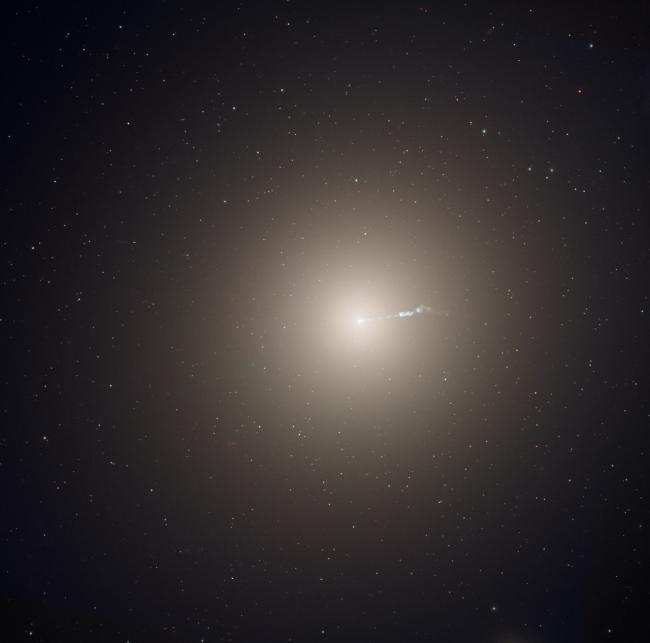- How do stars and planets form and evolve?
- Why do galaxies differ so much in size, shape, composition and activity?
- Stellar Structure and Evolution
- Galaxy Formation and Evolution
- Variable Stars and Binaries
- Time Domain Astronomy

Cambridge, MA -
In many ways stars are like living beings. They're born; they live; they die. And they even have a heartbeat. Using a novel technique, astronomers have detected thousands of stellar "pulses" in the galaxy Messier 87 (M87). Their measurements offer a new way of determining a galaxy's age.
We tend to think of stars as stable and unchanging. However, late in life stars like the Sun undergo a significant transformation. They become very bright and swell up to an enormous size, swallowing any planets that are within Earth's distance from the Sun. Near the end of their lifetime they begin to pulsate, increasing and decreasing their brightness by a large amount every few hundred days. In our own Milky Way galaxy many stars are known to be in this stage of life.
No one had considered the effects of these stars on the light coming from more distant galaxies. In distant galaxies the light of each pulsating star is mixed in with the light of many more stars that are not varying in brightness.
"We realized that these stars are so bright and their pulsations so strong, that they are difficult to hide," said Charlie Conroy, an assistant professor at Harvard University and astronomer at the Harvard-Smithsonian Center for Astrophysics (CfA), who led the research. "We decided to see if the pulsations of these stars could be detected even if we couldn’t separate their light from the sea of unchanging stars that are their neighbors."
The astronomers studied the elliptical galaxy M87, located 53 million light-years from Earth in the constellation Virgo. They examined a unique series of images taken with the Hubble Space Telescope over the course of three months in 2006. They quickly found what they were looking for.
"Amazingly, one in four pixels in the image changes with time," said Pieter van Dokkum, a professor and chair of the astronomy department at Yale University. "We tend to think of galaxies as steady beacons in the sky, but they are actually 'shimmering' due to all the giant, pulsating stars in them."
Analysis of the Hubble data showed that the average pixel varies on a timescale of approximately 270 days. The regular up and down changes in brightness are reminiscent of a heartbeat. "It's as if we're taking the pulse of the galaxy," said Conroy.
Their discovery offers a new way of measuring the age of a galaxy, because the strength and speed of a galaxy's heartbeat varies depending on its age. The team finds that M87 is about 10 billion years old, a number that agrees with previous estimates using different techniques.
The discovery of stellar heartbeats should not be specific to M87; every galaxy in the universe likely shows similar distinctive patterns. The next step is to take the pulse of other galaxies.
"Our models suggest that the pulsations will be stronger in younger galaxies, and that's something we'd love to test," said Jieun Choi, a graduate student at Harvard and a co-author of the study.
The galaxies will keep beating for a while longer. Said van Dokkum, "Cardiac arrest is not expected until a trillion years from now - that's a hundred times longer than the age of the universe."
The research is described in Nature's November 16 Advanced Online Publication in a paper authored by Charlie Conroy (CfA), Pieter von Dokkum (Yale University) and Jieun Choi (CfA).
Headquartered in Cambridge, Mass., the Harvard-Smithsonian Center for Astrophysics (CfA) is a joint collaboration between the Smithsonian Astrophysical Observatory and the Harvard College Observatory. CfA scientists, organized into six research divisions, study the origin, evolution and ultimate fate of the universe.
For more information, contact:
Christine Pulliam
Media Relations Manager
Harvard-Smithsonian Center for Astrophysics
617-495-7463
cpulliam@cfa.harvard.edu
Related News
CfA Celebrates 25 Years with the Chandra X-ray Observatory
Stellar Surf's Up: Monster Waves as Tall as Three Suns are Crashing upon a Colossal Star
The Making of an Astronomer
The Mysterious Dusty Object Orbiting TIC 400799224
Remembering Astronomer Henrietta Swan Leavitt
Astronomers Observe a New Type of Binary Star Long Predicted to Exist
Gamma-ray Scientists "Dust Off" Intensity Interferometry, Upgrade Technology with Digital Electronics, Larger Telescopes, and Improved Sensitivity
Projects
AstroAI
DASCH (Digital Access to a Sky Century @ Harvard)
For that reason, the DASCH (Digital Access to a Sky Century @ Harvard) team are working to digitize the plates for digital storage and analysis. The process can also lead to new discoveries in old images, particularly of events that change over time, such as variable stars, novas, or black hole flares.
Sensing the Dynamic Universe
SDU Website